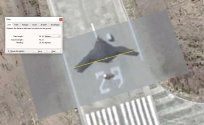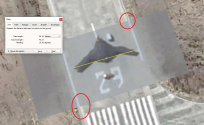And what does the same Chinese satellite say the wingspan of GJ-X is? Or do you not know the basics of how to do measurement?This is just a misinfo that has been widely circulated, ironically via a Chinese satellite we can basically confirm a wingspan of 46m for the B-21. As far as I know 46 is larger than 42.
You are using an out of date browser. It may not display this or other websites correctly.
You should upgrade or use an alternative browser.
You should upgrade or use an alternative browser.
Chinese UCAV/CCA/flying wing drones (ISR, A2A, A2G)
- Thread starter VESSEL
- Start date
While we were all pigeonholing our thoughts towards various anti-surface/ship roles based on the assumed GJ-x designation, we haven't stopped to consider multirole use.
Cranked wings allow for longer fuselage and generally means two things; 1. longer range and loiter time, 2. longer weapons bay vs the same wingspan pure flying wing.
With PLAAF being so heavily networked for CEC, they could quite easily have simply made an unmanned heavy multirole aircraft. Rather than going B-52 arsenal ship that is capable of dropping air to air missiles, why not have ULO heavies that perform A2A as well? You're not imparting the same kinetic energy or getting into closer ranged fights in the 100km - 20km window. The stealth would really allow you to flank if you have dozens of these heavy arsenal aircraft that can launch PL-17s 100km from the flank of targeted formations, or even fly closer towards valuable targets like tankers and AWACS.
Even 200km of target for PL-17 is well within NEZ. This thing looks like it can easily carry 6x PL-17s.
At the moment, nothing known in PLAAF inventory can carry PL-17 internally until J-36. This could be a seriously capable air to air platform. There is value in a 2x WS-10 powered unmanned, tailless ULO combat drone. You're definitely not limited to performing ISR, air to ground/ anti-ship.
Yes you're not supersonic which means losing a lot of value for A2A but you're ULO and you carry seriously long ranged air to air weapons that make PL-15 seem short legged. This more than makes up for a subsonic speed.
Before J-XD/J-50 and J-36, PLAAF has no tailless air to air platform. Why not bring that capability to this platform when it clearly has the ULO advantage and the space for carrying PL-17s internally.
Speaking of GJ-X being unmanned arsenal aircrafts for AAMs, similar ideas have indeed been brought up on the other side of the lake just a couple weeks ago:
So, yes - Something like the GJ-X should be able to carry at the very least a few AAMs inside its IWBs. And given the overall length of the center-body (~22-24 meters), the GJ-X can actually have an IWB that is ~9-10 meters long.
This would mean that a at least couple PL-17s could be fitted inside the GJ-X's IWB. Though, if we want to go further and utilize the full length of the IWB, that would mean XLRAAMs in the high-hundreds of kilometers (>600 kilometers) of maximum strike ranges. Otherwise, a 9-meter long IWB would enable a longitudinal dual-stacking of PL-15/16 LRAAMs.
This hasn't yet touch on the possibility of either a rotary launcher or vertical dual-stacking of AAMs inside the IWB, but that's a discussion for another time.
In the meantime, though - I'd prefer something in between the GJ-11/21 and GJ-X in terms of dimension, MTOW and payload capacity for such roles. This should make the platform not just being a viable and significant upgrade in terms of payload capacity and range/endurance over the GJ-11/21, but also not as expensive and is less prone to attrition than the GJ-X to enable procurement in greater numbers.
Last edited:
I'm not sure if you are being sarcastic or just utterly dense here but GJ-X is literally measured to be 42-43m wide via satellite pictures. Feel free to look back on this thread.And what does the same Chinese satellite say the wingspan of GJ-X is? Or do you not know the basics of how to do measurement?
Could have just answered you don't know how to do measurement lolI'm not sure if you are being sarcastic or just utterly dense here but GJ-X is literally measured to be 42-43m wide via satellite pictures. Feel free to look back on this thread.
In science when you want to compare two objects, you either use two different tools that you know the tolerance of, or you don't know the tolerance but you measure both with the same tool. Which is why I ask you what is GJ-X's measurement on the same Chinese satellite (and viewer software) that you measured B-21 with.
But I understand that's something they teach in college, and not everyone went to college.
Could have just answered you don't know how to do measurement lol
In science when you want to compare two objects, you either use two different tools that you know the tolerance of, or you don't know the tolerance but you measure both with the same tool. Which is why I ask you what is GJ-X's measurement on the same Chinese satellite (and viewer software) that you measured B-21 with.
But I understand that's something they teach in college, and not everyone went to college.
Uhm, you can just overlay the satellite image on top of a map tool and measure it. B-21 is ~46m vs ~42m of the GJ-X
There is of course some variance but it's not worth this fuss.
Speaking of GJ-X being unmanned arsenal aircrafts for AAMs, similar ideas have indeed been brought up on the other side of the lake just a couple weeks ago:
So, yes - Something like the GJ-X should be able to carry at the very least a few AAMs inside its IWBs. And given the overall length of the center-body (~22-24 meters), the GJ-X can actually have an IWB that is ~9-10 meters long.
This would mean that a at least couple PL-17s could be fitted inside the GJ-X's IWB. Though, if we want to go further and utilize the full length of the IWB, that would mean XLRAAMs in the high-hundreds of kilometers (>600 kilometers) of maximum strike ranges. Otherwise, a 9-meter long IWB would enable a longitudinal dual-stacking of PL-15/16 LRAAMs.
This hasn't yet touch on the possibility of either a rotary launcher or vertical dual-stacking of AAMs inside the IWB, but that's a discussion for another time.
In the meantime, though - I'd prefer something in between the GJ-11/21 and GJ-X in terms of dimension, MTOW and payload capacity for such roles. This should make the platform not just being a viable and significant upgrade in terms of payload capacity and range/endurance over the GJ-11/21, but also not as expensive and is less prone to attrition than the GJ-X to enable procurement in greater numbers.
Think about the possible permutations for a future high-end air combat:
H-20, GJ-X, WZ-X, J-36, J-XDS, CCA (x2), UADF (x2), KJ-3000, J-20, J-35, various tankers/special mission aircrafts, various other UAVs
Hmm, I don't know if I understand you. Satellite image only gives you number of pixels. It does not tell how many meters each pixel is. The actual size in meters can be deduced if you known the altitude, angle of the satellite and lens parameters when the image is taken. What kind of "map tool" are you talking about? I don't know any tool that can do the calculation other than the parameters of the actual satellites involved.Uhm, you can just overlay the satellite image on top of a map tool and measure it. B-21 is ~46m vs ~42m of the GJ-X
There is of course some variance but it's not worth this fuss.
Actually the issue of reliability applies to both sides whether B-21 is 40m or 46m, GJ-X is 42 or something else. This is why I am skeptical of all amateur "measurements". We can only get a rough idea of the size, that is all. But if any ariticle/person made a statement that failed math (137 < 132), that is laughable.
Last edited:
Metrology is a science for a reason, if you don't normalize for the tool and process you can't do any real comparisons.Uhm, you can just overlay the satellite image on top of a map tool and measure it. B-21 is ~46m vs ~42m of the GJ-X
There is of course some variance but it's not worth this fuss.
Case in point, GJ-X wingspan using commercial overlay method also gives you ~46m wingspan, not 42m per TWZ.
If TWZ estimated GJ-X as 42m, then their process will also estimate B-21 at ~40m.

Hmm, I don't know if I understand you. Satellite image only gives you number of pixels. It does not tell how many meters each pixel is. The actual size in meters can be deduced if you known the altitude, angle of the satellite and lens parameters when the image is taken. What kind of "map tool" are you talking about? I don't know any tool that can do the calculation other than the parameters of the actual satellites involved.
Actually the issue of reliability applies to both sides whether B-21 is 40m or 46m, GJ-X is 42 or something else. This is why I am skeptical of all amateur "measurements". We can only get a rough idea of the size, that is all. But if any ariticle/person made a statement that failed math (137 < 132), that is laughable.
Like this

Metrology is a science for a reason, if you don't normalize for the tool and process you can't do any real comparisons.
Case in point, GJ-X wingspan using commercial overlay method also gives you ~46m wingspan, not 42m per TWZ.
If TWZ estimated GJ-X as 42m, then their process will also estimate B-21 at ~40m.
View attachment 162952
You have done a poor job of overlaying it. You need to make sure it's precise. Use transparency tools to make it more accurate if needed.

Imagine PLARF, PLAN, H-20 and GJ-X destroying airbases so there won't even be air combat.Think about the possible permutations for a future high-end air combat:
H-20, GJ-X, WZ-X, J-36, J-XDS, CCA (x2), UADF (x2), KJ-3000, J-20, J-35, various tankers/special mission aircrafts, various other UAVs
